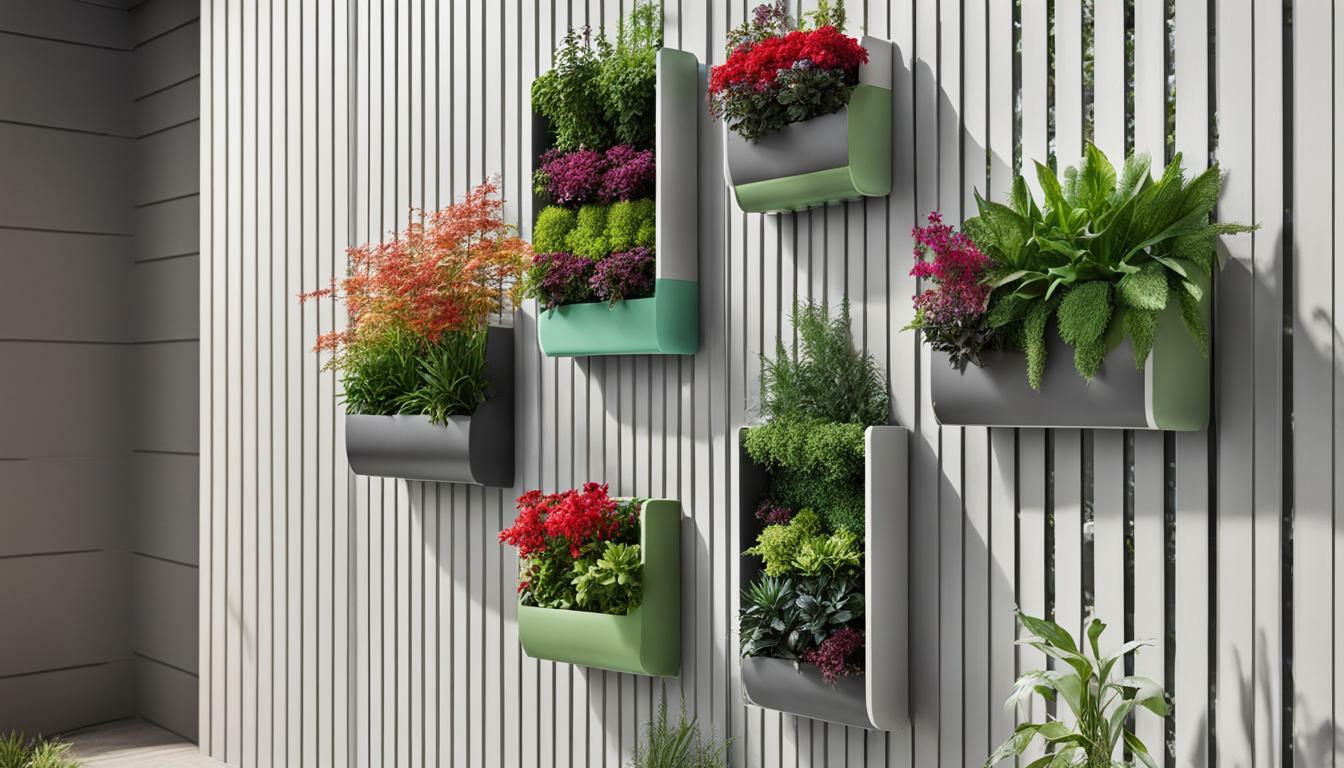- A PVC vertical garden allows you to grow more plants in a small space.
- Recycled PVC pipes are an environmentally friendly choice for building your vertical garden.
- With the right tools and materials, you can easily assemble and maintain your PVC vertical garden.
- Plants like lettuce, bok choy, herbs, and strawberries thrive in a PVC vertical garden.
- Safety considerations and alternative options should be taken into account when working with PVC.
Now let’s explore why PVC is a great choice for your vertical garden.
Why Choose PVC for Your Vertical Garden?
PVC is an excellent choice for your vertical garden due to its numerous advantages, including its durability and sustainability. PVC pipes are strong and can withstand the weight of plants, making them ideal for creating a sturdy structure for your vertical garden. Additionally, PVC is a cost-effective material that is readily available and easy to work with, making it a popular choice among DIY enthusiasts.
One of the key benefits of using PVC for your vertical garden is its durability. PVC pipes are resistant to weathering, moisture, and pests, ensuring that your vertical garden will stand the test of time. This is especially important for outdoor gardens, as they are exposed to the elements and need to withstand various weather conditions.
Furthermore, PVC is a sustainable option for gardening. By repurposing PVC pipes, you can divert them from the landfill and reduce waste. PVC is also a recyclable material, adding to its eco-friendly appeal. By choosing PVC for your vertical garden, you can contribute to a more sustainable and environmentally friendly gardening practice.
Benefits of PVC for Vertical Gardens:
- Durable and long-lasting
- Weather and moisture resistant
- Pest resistant
- Cost-effective and readily available
- Environmentally friendly and sustainable
When building your PVC vertical garden, it is important to take safety precautions and consider alternative options if you have concerns about PVC safety. While PVC is generally safe to use for gardening, there are some considerations to keep in mind, such as the potential leaching of chemicals into the soil. If you have reservations about using PVC, there are alternative materials and methods for vertical gardening that you can explore.
In conclusion, PVC is a versatile and practical material for creating a vertical garden. Its durability and sustainability make it an excellent choice for DIY enthusiasts looking to maximize their gardening space. By following the step-by-step guide provided in this article, you can master the art of PVC vertical garden DIY and enjoy the benefits of a thriving and beautiful garden.
Materials and Tools Needed
Before you start building your PVC vertical garden, gather the following materials and tools:
Materials:
- PVC pipe – 6-to-8-inch diameter by 4 ft. long
- PVC pipe – 1½-to-2-inch diameter by 4 ft. long
- Potting soil
- 16 pieces recycled cardboard, roughly 2-inch square
- 17 seedlings of lettuce and mixed greens
Tools:
- Cordless or electric drill
- 1-1/2 inch hole saw for drill
- ¼ inch drill bit
- Pencil
- Tape measure
Now that you have all the necessary materials and tools, you are ready to start building your PVC vertical garden.
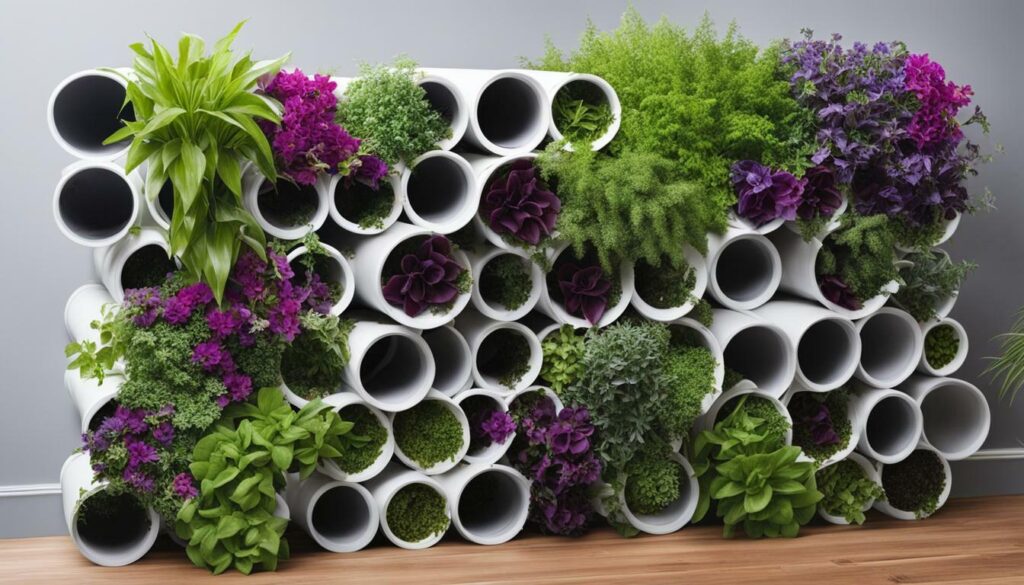
Note: Image for illustration purposes only.
Instructions:
- Mark four evenly spaced lines vertically down the large pipe. These will serve as guides for the holes you’ll drill.
- Measure 12 inches from one end and mark a line around the circumference of the pipe. For reference, mark this end of the pipe “DOWN” so you’ll remember that this end should go down into the soil when assembling your PVC tower.
- Using the hole saw, drill one hole where a vertical line intersects with a horizontal line. Now drill a second hole directly opposite, again at the intersection of a vertical and horizontal line. (Mind you, these holes do not have to be perfectly aligned; just get them in the ballpark.)
- Drill three more holes along the same vertical lines, leaving about 10 inches between holes. You now have two lines of four drilled holes.
- Drill three holes on each of the remaining vertical lines, offsetting each new hole so that it’s placed diagonally from those adjacent to it, making an alternating pattern.
- To use in the garden: Use a shovel to dig a 10-inch deep hole in the ground and bury the bottom end of the pipe almost to the first hole.
- To use on a patio or balcony, drill several holes in the bottom of a 5-gallon bucket or large planter and fill halfway with gravel. Place the pipe on top of the gravel and add soil around the pipe, filling to the top of the container.
- Drill about 30 randomly placed quarter-inch holes in the 2-inch PVC pipe.
- Place the small PVC pipe inside the larger PVC pipe so that the top of the inner pipe is slightly higher than the outer pipe. Once established, filling this inner pipe with water aids in getting moisture to the roots.
- Fill the large pipe with potting soil up to the bottom of the lowest holes, keeping the inner pipe centered.
- Fold a piece of cardboard into a V and set it inside the hole. Slide a seedling into each of the lowest holes, using the cardboard as a funnel of sorts. Gently push the piece of cardboard into the hole, being careful not to damage the seedling.
- Add more soil to reach the next set of holes and repeat the process of planting seedlings using the cardboard funnel.
- Add a few more plants in the top of the tower.
- Water the tower slowly from the top as well as into the 2-inch pipe to ensure proper hydration for your plants.
Following these instructions, you will be able to create your own PVC vertical garden and start enjoying the benefits of gardening in a small space.
Continue reading to learn about planting and caring for your vertical garden in the next section.
Cutting and Preparing the PVC Pipes
Start by measuring and cutting the PVC pipes according to the desired size for your vertical garden. PVC pipes are versatile and can be easily cut to your preferred length using a hacksaw or reciprocating saw. Secure the PVC pipes to your work surface with bar clamps to ensure stability during the cutting process.Once the pipes are cut to size, it’s time to prepare them for planting. The first step is to mark the planting holes on the larger PVC pipe. Using a white or silver marker, mark the holes approximately 6-8 inches apart. These holes will serve as the planting areas for your plants, so spacing is important.Next, use a drill and a 1-3/4-inch hole saw bit to punch out the marked holes. Be sure to smooth out any rough edges using a metal file to prevent any potential harm to your plants.To create drainage for your plants, take a 3/4-inch PVC pipe and use a 3/16-inch drill bit to bore holes throughout the pipe. This will allow excess water to drain out of the vertical garden and prevent waterlogging.To protect the root system of your plants and prevent soil erosion, wrap the 3/4-inch pipe with weed block material. Secure the weed block material in place using zip ties and cap both ends of the pipe with PVC caps.Now, you can assemble the vertical garden by placing the large pipe in the center of the planter. Slip the irrigation pipe inside the large pipe, ensuring it remains centered. Add about six inches of gravel to anchor the irrigation pipe.For outdoor use, dig a 10-inch deep hole in the ground and bury the bottom end of the large pipe, leaving only the planting holes exposed. If you prefer to use the vertical garden on a patio or balcony, drill several holes in the bottom of a 5-gallon bucket or large planter and fill it halfway with gravel. Place the pipe on top of the gravel and add soil around the pipe to the top of the container.To complete the preparation process, drill about 30 randomly placed quarter-inch holes in the smaller 2-inch PVC pipe. This smaller pipe will be inserted into the larger pipe and filled with water to aid in moisture distribution to the plant roots.With the PVC pipes prepared and the vertical garden assembled, it’s time to start planting. Gently tuck small starter plants into the marked holes, ensuring the cardboard or weed block material provides support and prevents soil from escaping. Water the plants thoroughly, both from the top and into the 2-inch pipe, to ensure proper hydration.Remember, a well-prepared PVC vertical garden can provide ample space for growing various greens, herbs, and even strawberries. With proper care and maintenance, you can enjoy a thriving garden in a limited space.| Materials | Tools |
|---|---|
| PVC pipe (6-to-8-inch diameter by 4 ft. long) | Cordless or electric drill |
| PVC pipe (1½-to-2-inch diameter by 4 ft. long) | 1-1/2 inch Hole saw for drill |
| Potting soil | ¼ inch Drill bit |
| 16 Pieces Recycled cardboard, roughly 2-inch square | Pencil |
| 17 Seedlings of lettuce and mixed greens | Tape measure |
“This simple vertical garden allows you to grow more than a dozen plants in one square foot of space by growing vertically.” – The Edible Front Yard Garden
Now that you have successfully cut and prepared the PVC pipes, you’re ready to assemble your PVC vertical garden. In the next section, we will guide you through the step-by-step process of assembling the tower garden and planting your chosen seedlings.
Assembling the PVC Tower Garden
Once your PVC pipes are prepared, it’s time to assemble the tower garden and get ready for planting. Follow these step-by-step instructions to create your PVC vertical garden:- Start by marking four evenly spaced lines vertically down the large pipe. These lines will serve as guides for the holes you’ll drill.
- Measure 12 inches from one end of the pipe and mark a line around the circumference. This end will be the bottom of the tower when assembling.
- Using a hole saw, drill one hole where a vertical line intersects with a horizontal line. Drill a second hole directly opposite the first hole. Continue drilling three more holes along the same vertical lines, leaving about 10 inches between each hole. Repeat this process on the remaining vertical lines, offsetting each new hole to create an alternating pattern.
- Drill about 30 randomly placed quarter-inch holes in the 2-inch PVC pipe.
- Place the small PVC pipe inside the larger PVC pipe, ensuring that the top of the inner pipe is slightly higher than the outer pipe. Fill the 8-inch PVC pipe with soil to elevate the height of the inner pipe if necessary.
- Fill the large pipe with potting soil up to the bottom of the lowest holes, keeping the inner pipe centered.
- Fold a piece of cardboard into a V shape and set it inside each hole. Use the cardboard as a funnel to plant seedlings into the holes, gently pulling and bending the cardboard into place between the seedling and the hole.
- Add more soil to reach the next set of holes and continue planting seedlings in this manner until each hole is filled.
- Add a few more plants to the top of the tower.
- Water the tower slowly from the top as well as into the 2-inch pipe to ensure proper moisture distribution.
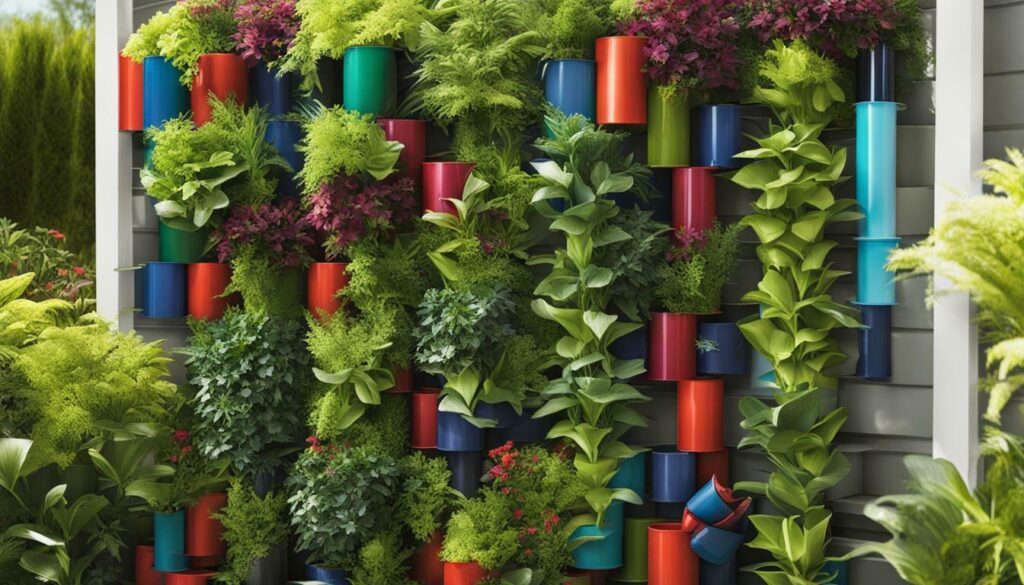 With the tower garden assembled, you are now ready to plant and watch your vertical garden thrive. Remember to water your plants regularly, provide proper care, and enjoy the benefits of your PVC vertical garden.
With the tower garden assembled, you are now ready to plant and watch your vertical garden thrive. Remember to water your plants regularly, provide proper care, and enjoy the benefits of your PVC vertical garden.| Materials | Tools |
|---|---|
| PVC pipe – 6-to-8-inch diameter by 4 ft. long | Cordless or electric drill |
| PVC pipe – 1½-to-2-inch diameter by 4 ft. long | 1-1/2 inch Hole saw for drill |
| Potting soil | ¼ inch Drill bit |
| 16 Pieces Recycled cardboard, roughly 2-inch square | Pencil |
| 17 Seedlings of lettuce and mixed greens | Tape measure |
Expert Tip: Easy Transplanting
To make transplanting seedlings into the PVC tower garden easier, consider using a metal sheet. Break down a metal can, such as a RAID can, to create a sheet. Insert the sheet into the soil along with the seedling, then push it down and remove the metal sheet. This method helps to keep the soil in place while planting and makes the process less cumbersome.With your PVC tower garden assembled and your plants in place, you can now enjoy the benefits of a vertical garden. Whether you choose to grow greens, herbs, or even strawberries, this innovative gardening solution allows you to maximize your space and create a beautiful and productive garden.Planting and Caring for Your Vertical Garden
Now that your vertical garden is assembled, it’s essential to know how to properly plant and care for your plants. With the right techniques and maintenance, your PVC vertical garden will thrive and provide you with a bountiful harvest. Here are some tips on caring for your vertical garden:- Watering your plants: One of the most critical aspects of caring for your vertical garden is ensuring adequate hydration for your plants. Due to the vertical structure, water may drain more quickly, so it’s important to water your plants regularly. Be mindful of the specific water requirements of each plant type and adjust your watering schedule accordingly. The use of an irrigation system or drip irrigation can help ensure even watering.
- Maintenance and fertilization: Regular maintenance is key to keeping your vertical garden healthy. This includes checking for pests or diseases, pruning or trimming plants as needed, and removing any dead or yellowing leaves. Additionally, fertilization is important to provide essential nutrients to your plants. Consider using organic fertilizers or compost to keep your garden sustainable.
- Providing adequate light: Ensure that your vertical garden receives sufficient light for optimal plant growth. Place your PVC tower garden in a location that gets at least 6 hours of direct sunlight each day. If you have limited sunlight, consider using grow lights or choosing plants that thrive in low light conditions.
- Harvesting and enjoying your vertical garden: As your plants grow and mature, you can start harvesting and enjoying the fruits of your labor. Harvest leafy greens when they reach their desired size, and harvest herbs as needed for culinary purposes. Remember to leave some plants for continuous growth and replanting to maintain a sustainable garden.
Table: Essential Tips for Caring for Your Vertical Garden
| Tips | Description |
|---|---|
| Watering | Ensure regular and proper watering of your plants to prevent dehydration. |
| Maintenance and Fertilization | Regularly check for pests, diseases, and provide necessary nutrients to your plants. |
| Lighting | Place your vertical garden in a location with adequate sunlight or consider using grow lights. |
| Harvesting | Enjoy the fruits of your labor by harvesting mature plants and herbs for culinary purposes. |
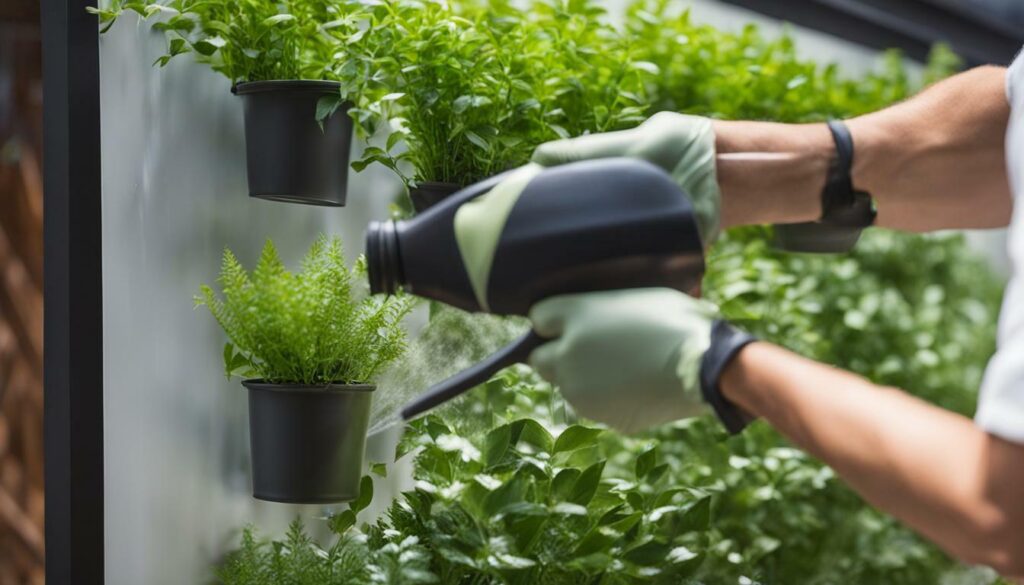
What to Grow in Your PVC Vertical Garden
There is a wide variety of plants that thrive in a PVC vertical garden. Here are some excellent options to consider:
- Lettuce: Lettuce is a popular choice for vertical gardens due to its compact size and quick growth. Varieties such as butterhead, romaine, and leaf lettuce are well-suited for PVC vertical gardens.
- Herbs: Basil, thyme, mint, and parsley are just a few examples of herbs that can be grown in a PVC vertical garden. These herbs not only add flavor to your meals but also provide a fresh and aromatic touch to your garden.
- Strawberries: Growing strawberries in a PVC vertical garden allows you to enjoy fresh, juicy berries without taking up too much space. The hanging position of the plants helps to prevent pests and diseases.
- Cherry Tomatoes: Cherry tomatoes are a great option for PVC vertical gardens, as their small size makes them perfect for hanging plants. Varieties such as Sweet 100, Sungold, and Tiny Tim are ideal choices.
- Flowers: If you want to add some color and beauty to your PVC vertical garden, consider planting flowers like petunias, pansies, or marigolds. These vibrant blooms will brighten up any space.
Remember to choose plants that have similar sunlight and water requirements, as this will make it easier to care for your vertical garden. It’s also important to provide proper support and regular maintenance to ensure healthy growth.
Take a look at this table for a quick reference of the plants mentioned:
| Plant | Watering | Sunlight | Care Tips |
|---|---|---|---|
| Lettuce | Regular watering | Partial shade | Harvest outer leaves for continuous growth |
| Herbs | Water when the soil is dry | Full sun/part shade | Pinch off flowers to encourage bushier growth |
| Strawberries | Regular watering | Full sun | Protect from birds with netting |
| Cherry Tomatoes | Regular watering | Full sun | Provide support for vines |
| Flowers | Varies by species | Varies by species | Deadhead spent blooms for prolonged flowering |
These are just a few examples of plants that can thrive in a PVC vertical garden. Get creative and experiment with different combinations to create a stunning and productive vertical garden.
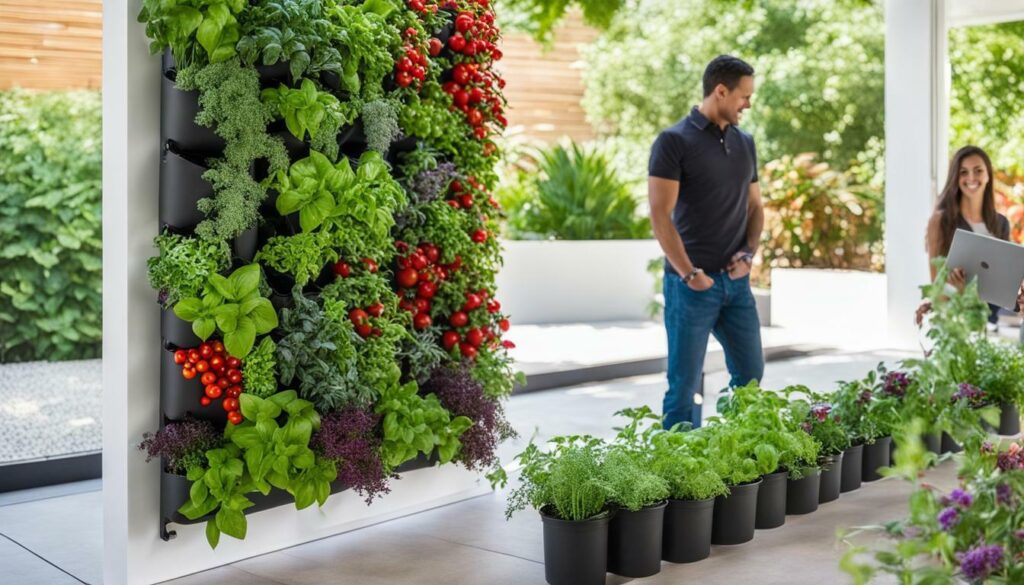
Safety Considerations and Alternative Options
While PVC is a popular choice for vertical gardening, it’s essential to consider safety and explore alternative options if desired. PVC pipes are generally durable and weather-resistant, making them suitable for outdoor use. However, there are some safety considerations to keep in mind.
First and foremost, it’s important to note that PVC pipes may contain additives and chemicals that could potentially leach into the soil and be absorbed by plants. While there is limited research on the exact effects of PVC on plant growth and human health, some individuals may prefer to avoid using PVC due to concerns about potential chemical exposure.
If you are concerned about the safety of PVC, there are alternative materials that you can consider for your vertical garden. One option is using sustainable and biodegradable materials such as wooden pallets or bamboo. These materials are environmentally friendly and do not pose the same chemical risks as PVC.
Alternative Vertical Gardening Methods
If you decide that PVC is not the right choice for your vertical garden, there are several alternative methods you can explore:
- Vertical garden kits: These kits typically include a structure made from materials such as metal or wood, along with containers for planting. They provide a convenient and safe option for creating a vertical garden.
- Living walls: Living walls, also known as green walls or vertical gardens, involve growing plants directly on a wall or vertical surface. They can be created using materials such as felt pockets or modular panels.
- Hanging planters: Hanging planters allow you to create a vertical garden by suspending individual pots or containers from a wall or structure. This method is versatile and can be easily customized to fit your space.
By exploring these alternative options, you can create a vertical garden that aligns with your safety preferences and design aesthetic. Remember to consider factors such as space availability, sunlight exposure, and maintenance requirements when choosing the best method for your needs.
| Pros of PVC Vertical Garden | Cons of PVC Vertical Garden |
|---|---|
| Easy to find and affordable | Potential chemical leaching |
| Durable and weather-resistant | Concerns about environmental impact |
| Customizable and versatile | May not be suitable for organic gardening |
Remember, the choice of materials for your vertical garden ultimately depends on your personal preferences and priorities. Consider the pros and cons of PVC, as well as the alternative options available, to make an informed decision that aligns with your values.
Conclusion
Congratulations! You have now mastered the art of PVC vertical garden DIY. It’s time to unleash your inner gardener and start creating your own space-saving, sustainable garden.
By using PVC pipes and following the step-by-step guide provided in this article, you can transform a small corner of your yard or balcony into a thriving vertical garden. PVC is a versatile and durable material that is perfect for creating a structure that can hold multiple plants in a compact space.
Not only will a PVC vertical garden make the most of limited space, but it also offers numerous benefits. It allows you to grow a variety of plants, from herbs to lettuce and strawberries, all within a single square foot. It is an excellent option for those living in urban areas or with limited gardening space.
Remember to gather all the necessary materials and tools, such as PVC pipes, potting soil, and a drill, before starting the project. Follow the step-by-step guide to cut and prepare the PVC pipes, assemble the tower garden, and plant your chosen seedlings. Once your vertical garden is set up, make sure to provide proper care and maintenance, including watering, fertilizing, and regular maintenance to ensure healthy plant growth.
While there are safety considerations surrounding the use of PVC, it is important to note that repurposing PVC pipes diverts them from the landfill and gives them a new purpose. However, if you have concerns about using PVC in your garden, there are alternative options for vertical gardening that you can explore.
In conclusion, PVC vertical gardening is a creative and sustainable way to maximize your gardening space and enjoy the beauty of nature. So, grab your tools, get your hands dirty, and start your PVC vertical garden DIY project today! Happy gardening!
Can I Use the PVC Vertical Garden for Different Types of Plants?
Yes, you can definitely use a vertical PVC pipe garden creation for different types of plants. The versatility of this gardening method allows for a variety of plants to be grown, from herbs and vegetables to flowers and succulents. The vertical design maximizes space and provides a unique, eye-catching display.
FAQ
Q: Why should I choose PVC for my vertical garden?
A: PVC is a durable and sustainable material that can withstand outdoor conditions. It is also readily available and easy to work with, making it an ideal choice for creating a vertical garden.
Q: What materials and tools do I need to build a PVC vertical garden?
A: You will need PVC pipe, potting soil, a hole saw, a drill, and various other gardening tools to assemble your PVC vertical garden.
Q: How do I cut and prepare the PVC pipes for the vertical garden?
A: To cut the PVC pipes, you will need to mark the desired locations for the holes and use a hole saw and drill to create the openings. You will also need to prepare the pipes by sanding the edges and adding drainage holes.
Q: How do I assemble the PVC tower garden?
A: The PVC tower garden can be assembled by placing the smaller PVC pipe inside the larger one and filling it with potting soil. You will then plant your seedlings in the designated holes and water the tower from the top and through the smaller pipe.
Q: What should I grow in my PVC vertical garden?
A: Small plants such as lettuce, herbs, and strawberries are suitable for growing in a PVC vertical garden. These plants are well-suited to the limited space and can thrive in the vertical growing environment.
Q: Are there any safety considerations when using PVC in the garden?
A: While it is not clear if PVC can leach chemicals into the soil, it is always recommended to seek alternatives if you have concerns about PVC safety. Additionally, following proper handling and disposal practices can minimize any potential risks.
Q: Are there alternative options for vertical gardening?
A: Yes, there are alternative methods for vertical gardening, such as using wooden structures, hanging planters, or utilizing vertical wall space. These options may provide alternatives for those who are concerned about using PVC in their gardens.

